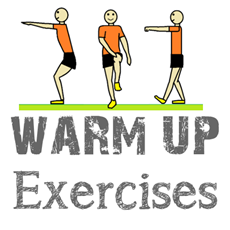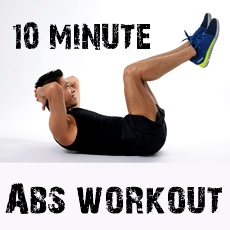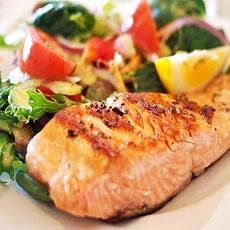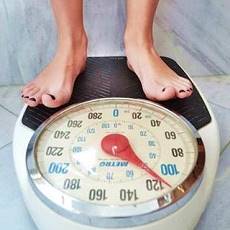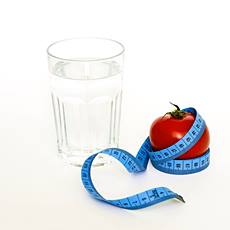Health Risks of a Large Waistline
Why does Waist Size Matter?
First published: 11.Oct.2018
Waist Size and Health Risks
Your waist size and your Waist-to-Hip Ratio are indicators of how much body fat you have, and where it is stored.
This has a direct impact on your health and the risk of disease associated with being overweight or obese even if your Body Mass Index (BMI) tells you that you are on the safe side of being fat.
In this article, we will discuss how to measure your waist and hip, how to calculate your health risk based on those measurements, and also talk about the science behind body shapes (popular wisdom has identified pear, apple, and avocado shapes), and their relationship with health risks.
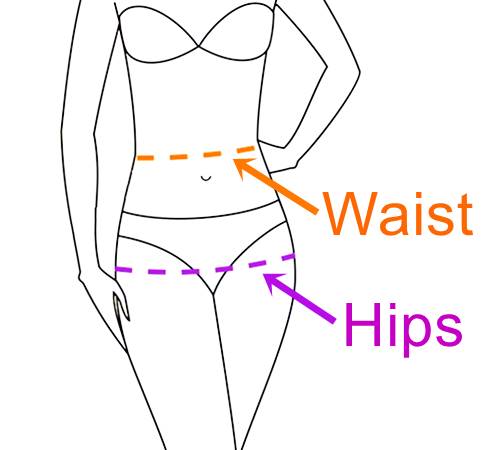
Large Waist Circumference is bad for your Health
A strict statistical analysis or meta-analysis performed in 2020 by Ahmad et al.(2020) (1), screened almost 100,000 studies and analyzed data covering over 2.5 million participants to determine the impact of a large waistline on your health.
The meta-analysis found a clear link between a large waistline and a higher risk of dying sooner:
For each 10 cm [4 inches] increase in waist circumference, we found an 8% and a 12% higher risk of all-cause mortality in men and women, respectively
Ahmad et al. 2020
The numbers could be even worse for western populations. Ahmad's team included Asians, Africans, and Non-Western groups, but when only western populations are considered, the risk goes up to 14% and 18% higher risk for men and women for every 4 inches (10 cm) increase in their waistline.
The study concludes that "Central fatness, reflected by large waist circumference, waist-to-hip ratio, and waist-to-height ratio, independent of overall adiposity, was associated with a higher risk of all cause mortality".
Take-home point
Men and women with a wide waistline are at increased risk of dying young.
Waist Circumference and your Health
Body Mass Index or BMI is a relationship between weight and height that is used to define if a person has a normal weight, or is overweight or obese.
On our Body Mass Index calculator page, we mention the shortcomings of the Body Mass Index as an indicator of being overweight or obese.
Some studies have even shown an inverse relationship between BMI and mortality (2), meaning that people with a higher BMI may have a lower death risk than others who have a lower BMI.
For this reason, other indicators for body fat are necessary, and the Waist Circumference (WC), as well as the Waist-to-Hip ratio (WHR) have also been adopted as tools to more accurately identify individuals who are at a higher risk of developing obesity-related health complications.
So even if your BMI is under 25, meaning your weight is within the healthy range, you can still have excess fat in your tummy (increasing your waistline). And this increases your risk of developing life-threatening conditions such as heart disease, stroke, and Type-2 diabetes.
Therefore, measuring your waist circumference and your WHR are simple ways to check out how much fat you are packing in your belly!
How to measure your waist
It is very easy to measure your waist and your hip girth. But you must be methodical and follow these steps (3):
- You should stand with feet close together, relaxed, your arms hanging at the side, and your body weight evenly distributed on both your legs.
- Wear little clothing.
- Exhale and measure at the end of a normal expiration.
- The tape measure should be parallel to the floor.
How to Measure the Waist Circumference
The waist is located at the midpoint between the lower edge of the last palpable rib and the top of the iliac crest.
The iliac crest is the curved upper edge of a bone known as "ilium" which is part of your hip bone. You can feel it beneath your skin in the hip region when you place your hands on your hips. See the image, where the iliac crest is highlighted in red.
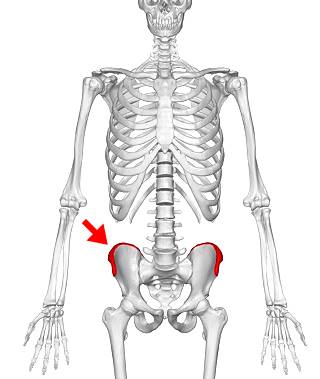
Location of the iliac crest. DBCLS
Do not measure the waist at the level of the navel (belly button), some reports (4) indicate if you measure the waist there, you may underestimate the true waist circumference.
Place the tape measure and take two measurements here, at the waistline, check if they differ by less than 0.4 inches (1 cm), if so, average the values you measured. If the difference is larger than 0.4 in. (1 cm) repeat the measurement and take two new measurements.
An example of how to calculate the average value:
- Measurement #1: 36.8 inches
- Measurement #2: 36.6 inches
Check the difference: 36.8 - 36.6 = 0.2 inches. Which is less than 0.4 inches. So we keep the measurements and calculate their average:
Average waist size
To calculate the average, add both values and divide the total by 2:
36.8 + 36.6 = 73.4 inches
73.4 / 2 = 36.7 inches
The average waistline is, therefore: 36.7 inches.
Measure your Hip Circumference
This one is easier than measuring your waist. Place the tape around the widest portion of the buttocks (tape parallel to the floor). Take two measurements and proceed as indicated above (discard if they differ by more than 0.4 in - 1 cm, or average the values if the difference is less).
Lets assume: value #1 is 47.1 inches and value #2 is 47.4 inches. Difference (47.4 - 47.1 = 0.3 in.) is less than 0.4 in. so we can safely average both values:
47.4 + 47.1 = 94.5, and
94.5 / 2 = 47.25 inches for the "average" hip circumference.
The Tape Measure
Use a stretch-resistant tape measure and apply a constant tension of 0.22 lb. to it (100 g).
How tight should it be?
The tightness of the measuring tape is critical! Don't pull it so tight that it constricts. It should fit snugly but not constricting.
What do your waist and hip measurements mean?
Use our Waistline Chart and learn what actions to take
Compare your waistline with the values in the following chart:
Risk Level Women
Waist measurement
Low
Well done!
less than 31.5 in. (80 cm)
Medium
Lose weight
31.5 in. (80 cm) or more
Very High Risk.
Visit your doctor
34 in. (88 cm) or more
Risk Level Men
Waist measurement
Low
less than 37 in. (94 cm)
Medium.
Lose weight
37 in. (94 cm) or more
Very High Risk.
Visit your doctor
40 in. (102 cm) or more
For example, a man with a 36.7-inch waist is at a Low-Risk Level. This means that his abdominal fat is at a healthy level.
A woman with an average hip circumference of 36 inches is in the High-Risk group and should consult with her physician.
Waist-Hip Ratio or WHR
The Waist-Hip Ratio is a very good way to predict your health risk.
To calculate this Waist-Hip Ratio (WHR) simply divide your waist measurement by your hip measurement.
We will use the values of our previous example:
Waistline: 36.7 in and Hip circumference: 47.25 in.
WHR is: 36.7 / 47.25 = 0.77
Use our WHR Risk Chart
Use the following table (5) to assess the risk entailed by your Waist-Hip Ratio:
Risk Level Women
Waist- Hip Ratio
Low
less than 0.8
Moderate
0.81 to 0.85
High
Above 0.85
Risk Level Men
Waist- Hip Ratio
Low
less than 0.95
Moderate
0.96 to 1
High
Above 1
For example, our subject, a man with a WHR of 0.77 is well below the cutoff level of 0.95 so his risk is "Low".
But what should you do if your WHR falls in one of the other two categories (Moderate or High health risk)? Read on below:
Pear, Avocado, and Apple shaped bodies
Although each body is different, popular wisdom has identified some similar body-shape traits and identified them with certain fruit shapes:
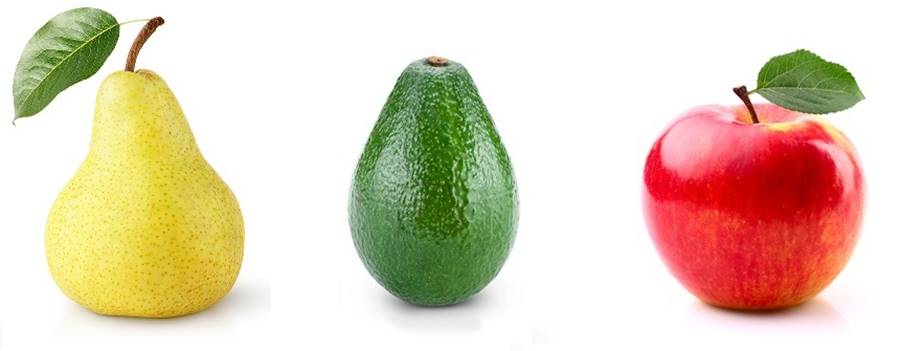
Apple-Shaped People
These people carry most of their weight in their abdomen, around their middles.
They have excessively round chests and stomachs. This rounded appearance gives them their name of "apples".
Pear-Shaped People
Those who store their fat below their waist: in their thighs, buttocks, and hips are more "pear" shaped. Their hips are wider than their shoulders, and they have normal-sized chests and waists.
Avocado-Shaped People
There is yet another shape, which falls between that of the "pears" and the "apples", an intermediate shape: the "avocado":
Is this a Myth?
There is a scientific basis to this popular knowledge, and these different body shapes are reflected by their WHR as we can see in the following table:
Riopelle (2017) (6) prepared this table for men, indicating body shape, WHR, and associated health risk level:
Body Shape
Waist- Hip Ratio
- - -
less than 0.85
Normal
Low Risk
- - -
0.85 - 0.95
Overweight
Moderate to High Risk
Pear
0.95 - 1.00
Obese
High to Very High Risk
Avocado
1.00 - 1.05
Severe Obesity
Very High Risk
Apple
above 1.05
Very Severe Obesity.
Extremely High Risk
Riopelle also points out the risks involved in having an apple-shaped body:
Body shape and fat distribution are more predictive of future disease than Weight and Body Mass Index (BMI). An apple-shaped figure, as opposed to a pear-shaped figure, correlates to a greater Waist-To-Hip ratio and a greater health risk for Type 2 Diabetes Mellitus (T2DM)...
Riopelle, 2017
BMI can overestimate obesity since it neglects to account for lean body muscle. The Waist-To-Hip Ratio (WHR) and Waist Circumference (WC) are better alternatives than the BMI to measure body shape.
So, having an apple, avocado, or pear-shaped body is no laughing matter. You should take immediate action to lose weight.
The Genetics behind Body Shape
Studies involving twins suggest that between 22% and 61% of the variability in the waist-to-hip ratio may be accounted for by genetic factors (7).
There is evidence that suggests that the patterns of fat deposition in the abdomen (known as "central obesity"), that causes apple-shaped or pear-shaped bodies, are "highly heritable" (8).

There is also strong evidence of genetics in the link between insulin resistance and central obesity so the effect of genes is compounded: they cause central obesity and alter metabolism, leading to increased health risks.
Obesity is the outcome of the interplay between environmental factors (such as lifestyle) and genes. But recent findings suggest that "there is a genetic component in lifestyle" (7) where genes that affect emotion and appetite are also associated with Body Mass.
Nevertheless, we are not slaves of our genes, we can take action and regain control of our bodies, lose weight and improve our health, and the quality of our lives.
Take-home point
There is a genetic component to central obesity.
Health Risk Associated with the Waist-To-Hip Ratio
WHR is better than BMI to predict health risks
For people afflicted with coronary artery disease (CAD), central obesity is the key indicator associated with higher mortality.
This risk is independent of their Body Mass Index or BMI (9).
In other words, BMI is not directly associated with mortality in subjects with CAD. They may even have normal or high BMIs, but it is the "central obesity" which is linked with a higher chance of dying.
The fatty tissue of central obesity interacts with the vascular system and increases insulin resistance and hypertension. Visceral fat provokes inflammation and increases the "bad" LDL cholesterol, and also lowers the "good" HDL cholesterol. All of these factors increase health risks (9).
Taking Action: Losing Weight
So, if your Waist Circumference (WC) or your Waist-to-Hip Ratio (WHR), or your Body Mass Index (BMI) place you in a risk category, take action right away.
You should lose weight around the stomach.
Weight gain is caused by putting more calories into your body than it needs. The extra energy is stored inside your body as fat.
The key to losing weight is to eat less (put fewer calories into your body) and lead a more active life (burn more energy). Ideally, you should burn more calories than you intake so your body will have to get its energy from the stored fat.
Our website has plenty of information on weight loss, getting fit, and nutrition information. You can get started now by visiting our "Fitness" page:
Read More at our:
> > Fitness webpage (Packed with advice and tips on getting into shape)
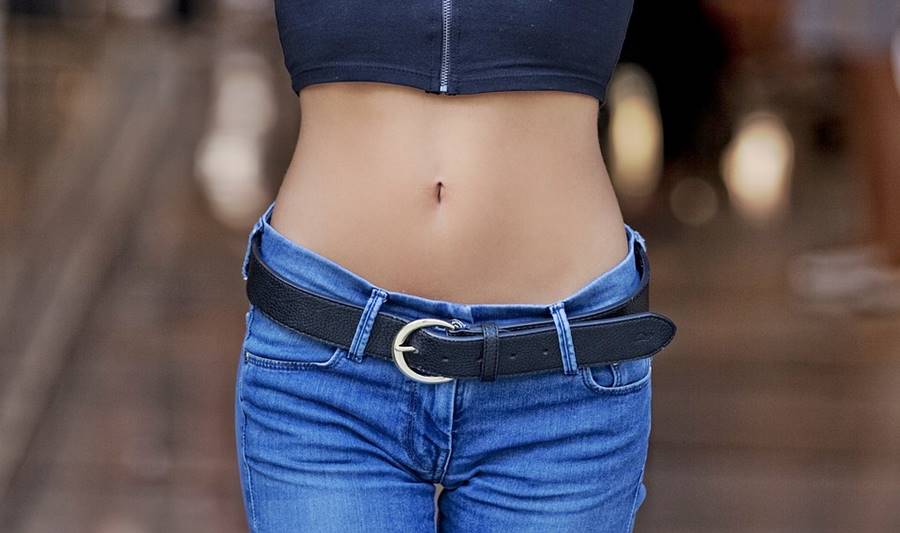
Read More:
References and Further Reading
(1) Jayedi Ahmad, Soltani Sepideh, Zargar Mahdieh Sadat, Khan Tauseef Ahmad, Shab-Bidar Sakineh, (2020). Central fatness and risk of all cause mortality: systematic review and dose-response meta-analysis of 72 prospective cohort studies. BMJ 2020; 370 :m3324
(2) Smith, David (2016). Waist-To-Hip Ratio vs. Body Mass Index as a Predictor of Total Mortality for People with Normal Weight and Central Obesity. School of Physician Assistant Studies. Paper 571.
(3) Waist Circumference and Waist-Hip Ratio Report of a WHO Expert Consultation. World Health Organization, Geneva, Dec. 8 - 11, 2008
(4) Croft JB, Keenan NL, Sheridan DP et al., (1995). Waist-to-hip ratio in a biracial population: measurement, implications, and cautions for using guidelines to define high risk for cardiovascular disease. Journal of the American Dietetic Association, 95(1):60-64
(5) Assessing Your Weight and Health Risk. UCLA
(6) Riopelle D, Van P. (2017) Riopelle Fat Type Level: A Simpler Way for Men to Understand Body Shape and Health Risks. J Obes Weight-Loss Medic. v.3:17 doi.org/10.23937/2572-4010.1510017
(7) Heid, Iris M, et al., (2010). Meta-analysis identifies 13 new loci associated with waist-hip ratio and reveals sexual dimorphism in the genetic basis of fat distribution. Nature, 42:929, 2010. http://dx.doi.org/10.1038/ng.685, - 10.1038/ng.685
(8) Fu J, Hofker M, Wijmenga C. (2015). Apple or pear: size and shape matter. Cell Metab. 2015 Apr 7;21(4):507-8. doi: 10.1016/j.cmet.2015.03.016.
(9) Coutinho, T., Goel, K., Correa De S, D., Kragelund, C., Kanaya, A. M., Zeller, M., Lopez-Jimenez, F. (2011). Central obesity and survival in subjects with coronary artery disease: A systematic review of the literature and collaborative analysis with individual subject data. Journal of the American College of Cardiology, 57(19), 1877-1886. DOI: 10.1016/j.jacc.2010.11.058
About this Article
Why waist size matters: the health risks of a large waistline, A. Whittall
©2018 Fit-and-Well.com, 11 Oct. 2018. Updated. 26 Nov. 2020. https://www.fit-and-well.com/fitness/waist-size-matters.html
Tags: Waist Size, Waist Circumference, Waist-to-Hip Ratio, WHR, Obesity, Abdominal Fat, BMI Calculator.
This Webpage
Subject: Fit-and-Well.com. Why waist size matters: the health risks of a large waistline. Large Waist size, waist-to-hip ratio, and waist circumference are indicators of obesity, belly fat, and an increased risk of dying sooner. Learn the health risks of a large waistline. How to measure your waist and hips, Waist-to-Hip ratio. Body shapes (pear, apple, avocado). Implications regarding weight management.

